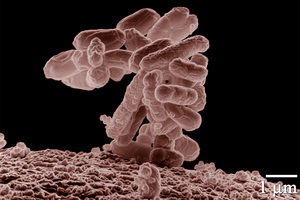A “foodborne illness” is an illness caused by bacteria or other pathogens in the food we eat.
How common are foodborne illnesses? The Centers for Disease Control and Prevention (CDC) estimates that in the United States alone, there are 76 million cases per year of foodborne illness. So each year there is roughly one instance of foodborne illness for every four Americans.
That statistic is an indication that food safety is a serious matter, but it’s not quite as alarming as it might seem. First, the overwhelming majority of such illnesses are minor and brief, with minimal symptoms and no long term effects. Second, many of the cases that are a little more serious but still symptomatically only at the level of a common cold or mild flu are in fact routinely mistaken for flu. Thus even if we’re getting sick from our food a little more than you realized, we’re also getting the flu corresponding less than you thought. So that’s a wash.
But that’s not to say that zero foodborne illnesses are severe. The CDC estimates that 325,000 hospitalizations and 5,000 deaths related to foodborne illnesses occur in the U.S. annually.
The most common pathogens that cause foodborne illnesses are:
* Calcivirus (or Norwalk virus): If you’ve ever been deathly ill for a day or two, vomiting and weak and miserable and cursing anything and everything you’d recently eaten, wondering what kind of stomach flu or food poisoning you had, there’s a fair chance you were suffering from the effects of the calcivirus. This virus typically is not present in food except as a temporary means of transport. That is, it’s passed from person to person, but often that person is one who was handling your food, like a cook in a restaurant who hasn’t washed his hands properly.
* Campylobacter: The campylobacter bacteria lives in the intestines of birds, and we get it most often from eating undercooked poultry. It causes stomachache and fever, and is the most commonly diagnosed bacterial cause of diarrhea.
* E. coli: The notorious e. coli bacteria is found in many animals. We are most likely to get it from food that has come in contact with cattle feces. It causes a particularly severe diarrhea and abdominal pain. Worse yet, in a minority of cases (under 5%), it can in effect lie dormant for weeks after those initial unpleasant symptoms, only to return to cause much more serious damage up to and including kidney failure and death.
* Salmonella: Salmonella is another bacteria found in many animals, which we can get when we eat meat that has not been cooked enough or not been prepared in sanitary conditions. It causes fever, diarrhea, and cramps.
In order to avoid experiencing one of the 76 million cases of foodborne illness this year, be sure that all areas where food is prepared are kept clean, and that anyone who handles food washes their hands thoroughly. Remember the expression “Keep cold foods cold and hot foods hot.” Bacteria multiply fastest at temperatures between about 40 F and 140 F. Food that’s frozen, refrigerated, or thoroughly cooked is outside that range.
Sources:
“Foodborne Illness.” Centers for Disease Control and Prevention
“Foodborne Illness & Disease.” United States Department of Agriculture


